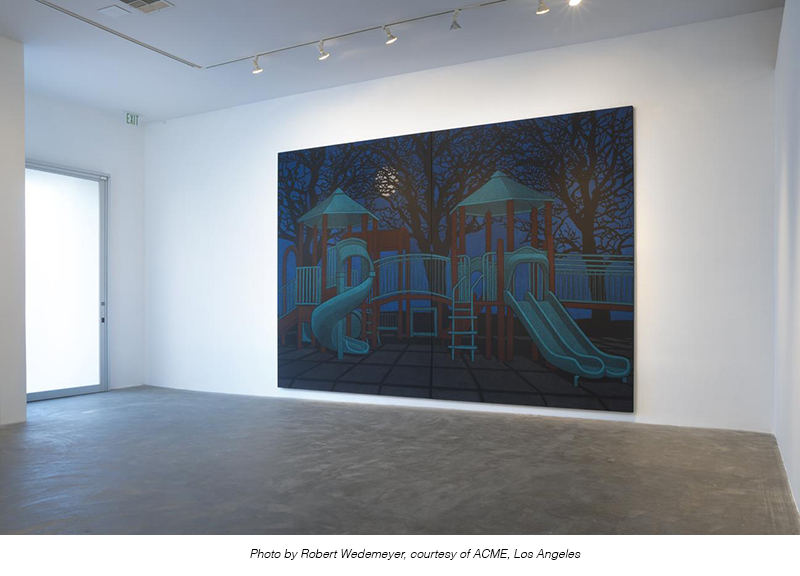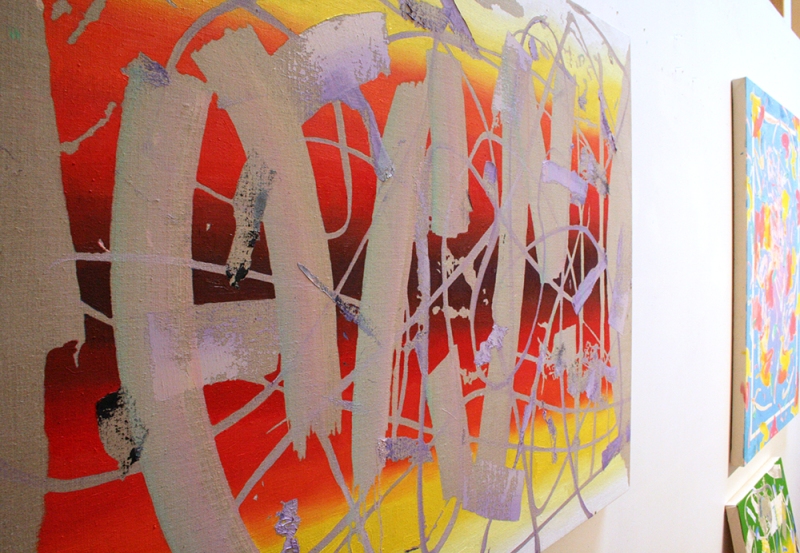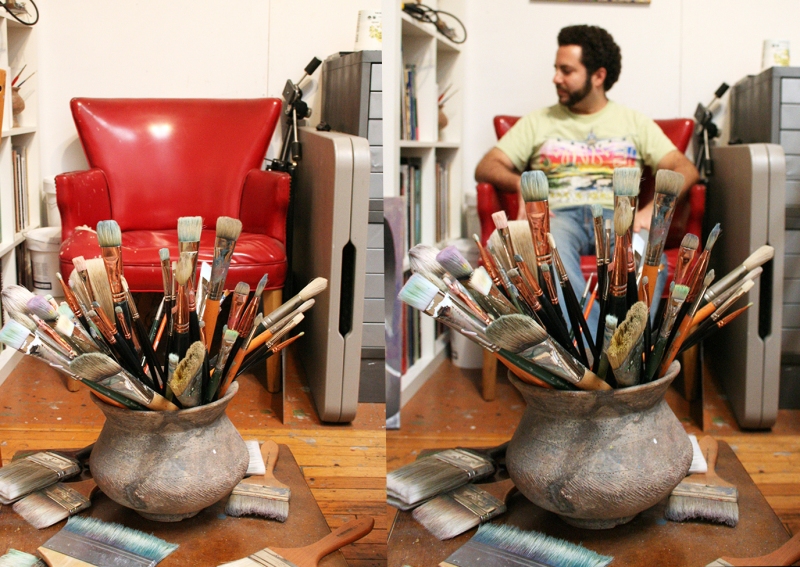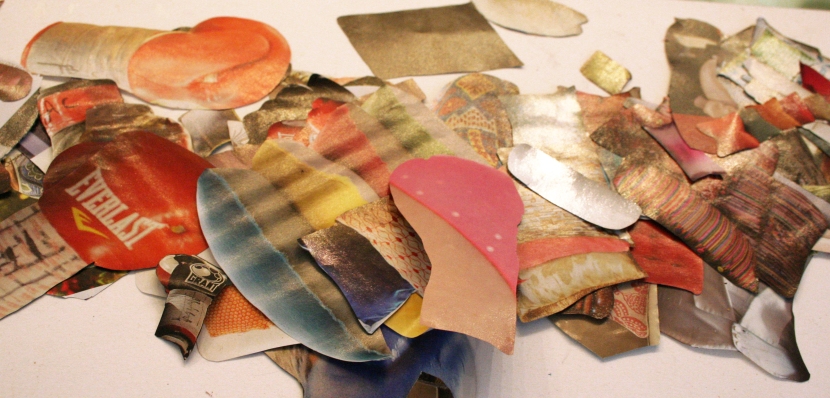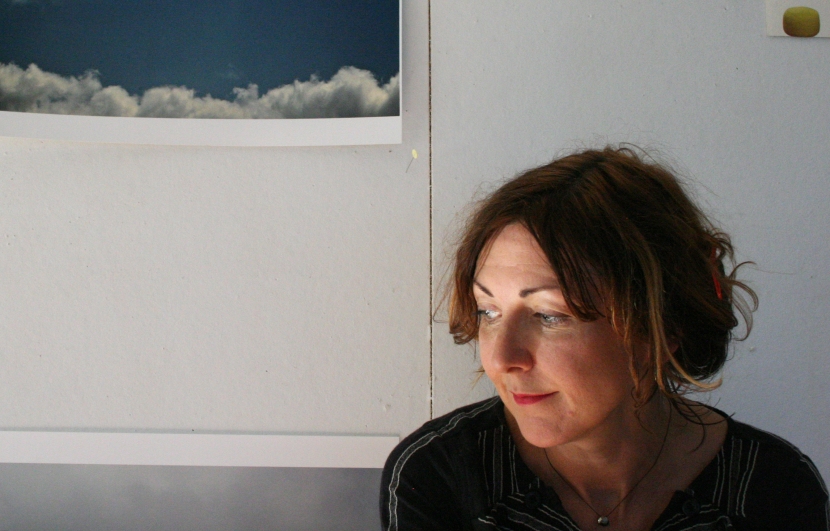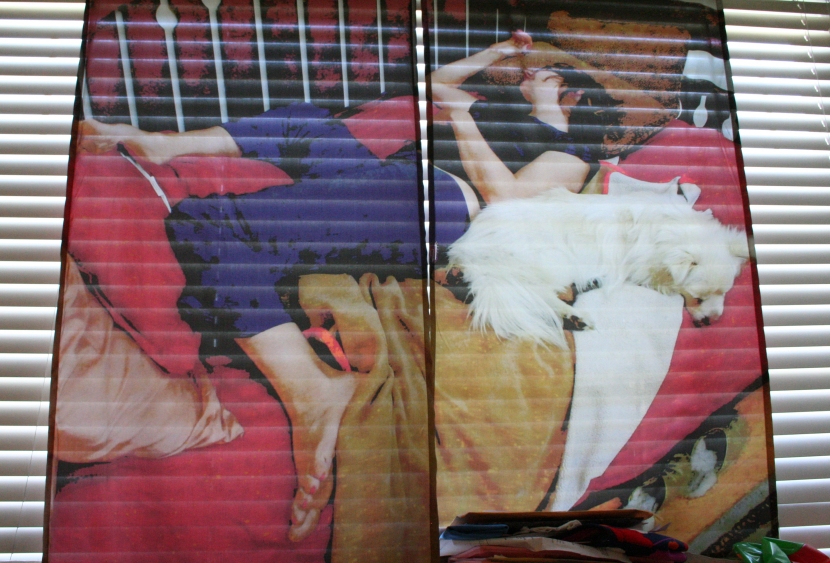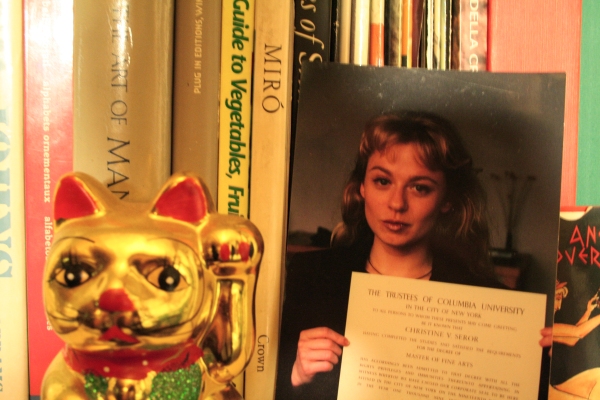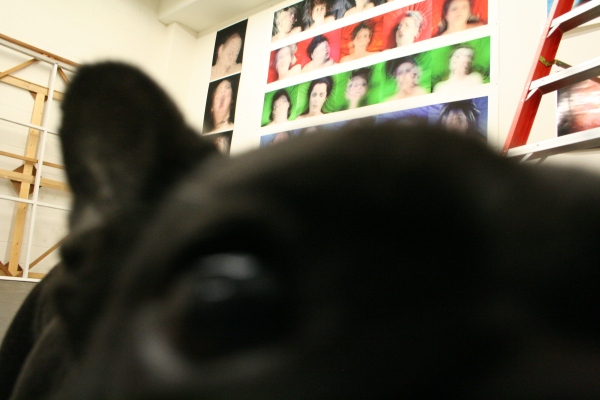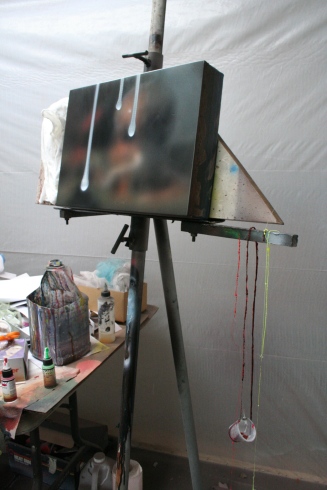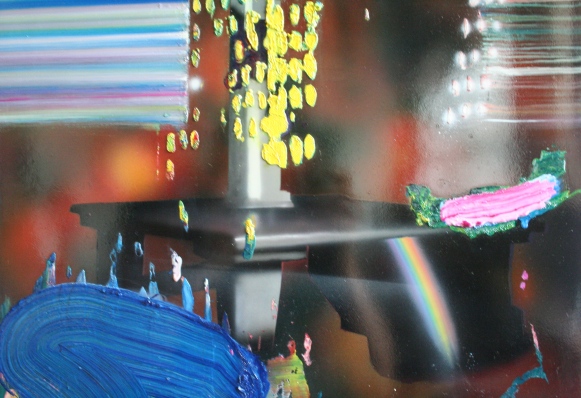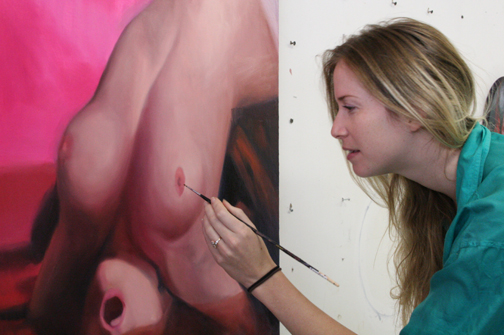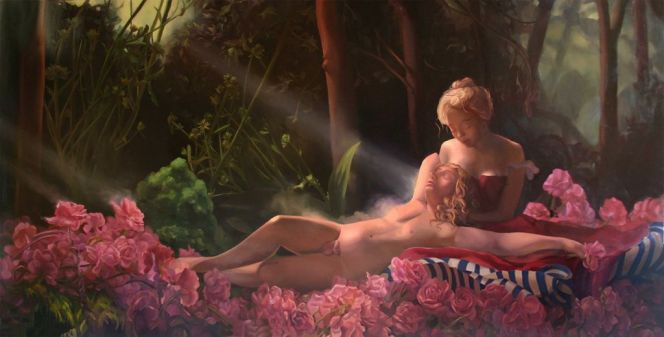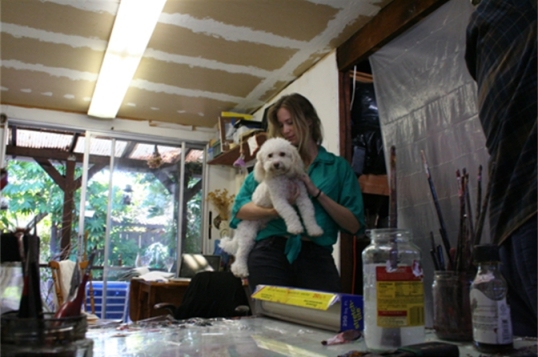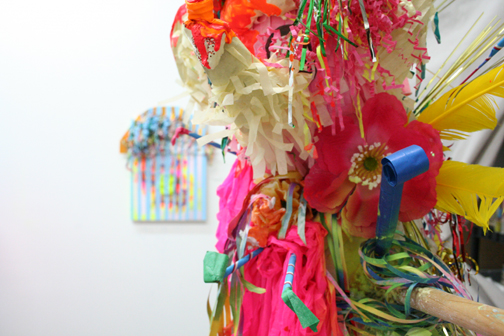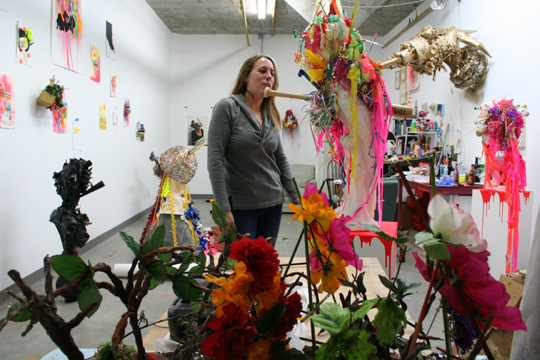Tagged: art
A Roving Locus
A CONVERSATION WITH AMY ADLER
Interview by Virginia Broersma
 I first saw Amy Adler’s work at the Museum of Contemporary Art San Diego many years ago when I was probably still in college. Her “Director” series was being exhibited and the work continues to stick with me over all these years. The pieces are subtle – faint pastel drawings on white canvas – which draw you into them by necessity in order to see them. When I learned that they were images of a filmmaker in the act of directing Amy (who remains an unseen performer in the works) I was intrigued by the complications of what (or who) is actually the subject.
I first saw Amy Adler’s work at the Museum of Contemporary Art San Diego many years ago when I was probably still in college. Her “Director” series was being exhibited and the work continues to stick with me over all these years. The pieces are subtle – faint pastel drawings on white canvas – which draw you into them by necessity in order to see them. When I learned that they were images of a filmmaker in the act of directing Amy (who remains an unseen performer in the works) I was intrigued by the complications of what (or who) is actually the subject.
This has been a regular consideration in Adler’s work: alluding to things unseen while complicating singular definitions of her subjects and mediums. She has made drawings, which she then photographs and destroys to leave only the photograph as the final artwork. She has created drawings for a children’s book that was never created. She has drawn herself playing imagined instruments, implying a song that will never be heard. Her latest project, “Location”, which is currently on view at ACME in Los Angeles, includes large scale oil pastel drawings created from photographs she took while scouting for a film, that may or may not ever be made. This being the first work of Adler’s without any figures, I was eager to speak with her to learn more about this project.
Virginia Broersma: I usually talk with artists in their studios, but since we are at your exhibition that is currently on view at ACME, I’m interested to hear how the experience of looking at your work is similar or different when looking at it in the gallery versus in your studio. How do you feel sitting here with the work in the gallery?
Amy Adler: Well, the biggest answer to that (or most significant right now) is that I was thinking about a film making term, which is “picture lock” – when you finish editing a film and that’s it; no one is going to touch it again. I’ve never really thought about that term with drawings before. I think somehow seeing them here they become locked in a way. In my studio I feel like they’re living and breathing and I can still change things. Here they’re off limits. That’s a huge adjustment for me. That’s the number one thing I’d say: that they’re no longer interactive with me as an artist. They’re in their own removed state.
Looking at them here in the gallery, do you have any impulse to keep working on them?
No, I don’t actually. The way I worked on them was that I had these five pictures and they were installed around the room. Every time I did something to one of them, I’d continue around the room and do the same thing to all of them. I went around the room probably four or five times over three years, because when I say doing “one thing”, it sometimes takes three months. So by the time I made the last trip around, everything I was doing was the last time.
These pieces are drawn from places you photographed while scouting locations for a film, which is where the title of the exhibition, “Locations” comes from. Were you scouting for a film you will be making?
I started making films just within the past few years, and I think that I’ve been asking myself (and other people have been asking me) am I a filmmaker now? Or an artist? And it’s not a straightforward answer. I think this project is a really good example of how those aren’t hard definitions.
The thing is that I actually was writing a short script and there was a scene that took place on a play set. So I’ve been photographing them for a while. After looking at them over a period of time in my archive that I was building, I started thinking about them more as abstract sculptures in the landscape. I actually started thinking of them as drawings in space, because their colors and lines and shapes and composition…. I thought, well OK, this is a drawing, this is not a film, actually. I feel like the script fed into the drawings, and it is really complicated how I now think about making the film.
All the pieces in this show are of play sets – how did you choose that particular subject?
For me, when I land on a subject, it usually is because there are a few different reasons. There isn’t one reason, but a few going on at the same time. For example, I’ve never done a show of just landscapes. I’ve always had people in my work and I’ve actually done very little landscape at all in the work. Also, because I’ve been thinking so much about drawing as sort of outside of the realm of art, and where it potentially exists in nature – that these are actually drawings in space; how drawing exists outside the context of just what we think of as art, but in the landscape.
Also, in a lot of my work I’ve spent a lot of time thinking about this idea of what you don’t see. Even though there aren’t figures in this work I feel like they’re incredibly present, you can hear them and sense them and practically feel like they’re going to go running into this any minute.
Well, you almost become more aware of them because of their absence. These are spaces that are meant to be activated by people or children, and because they’re not there, you are almost more aware of them and wonder why you don’t see them. It becomes a point of focus.
There’s a piece I did called “Phantom Instrument” and it’s this performance where I’m playing all these instruments that you don’t see. The focus is this thing that isn’t there. I really love that idea. I think it’s really interesting if you can create that with drawing.
Yeah, this stuff is really my driving force. I’m always thinking on these levels, but on the other hand, I’m aware that the drawings themselves have to perform free of my intentions.
My experience first seeing them was that the playground was such an unexpected subject. As I continued to look, I became more focused on the formal elements, the almost rudimentary forms – the primary colors and seemingly simple lines. But then you realize how complex the pieces are, like a puzzle. I began to notice the beautiful choices you’ve made with the shadows of the trees or the silhouetted branches and how they become graphic shapes, or the smooth curl of the slide; I find myself quickly losing sense of the identification of it as a playground and being caught up in the attraction of looking at them.
That’s kind of what I was thinking when I described that kind of hallucination. I really went in and out of thinking of them as specific objects. Puzzle is a good word – I like that a lot. All the black space is negative space. That was really exciting to me – the richness and potential of all that black void. It’s in every single drawing and it has a big role – the raw canvas.
There is something very basic about the construction, but at the same time, within each one there’s some really complicated challenges, I have to say. There are a lot of really goofy moments. There are some moments that work really beautifully, but there’s definitely some moments that are… for example, some of the architecture – if you spend a lot of time, you would start to identify things that don’t necessarily connect. Things that have no logic. But it takes a long time to notice them, even for me. Like I never noticed that that pole doesn’t go anywhere, you know? But I love that – that you can make something so colossal and still have these weird spontaneous moments where things don’t make sense, or surprise you.
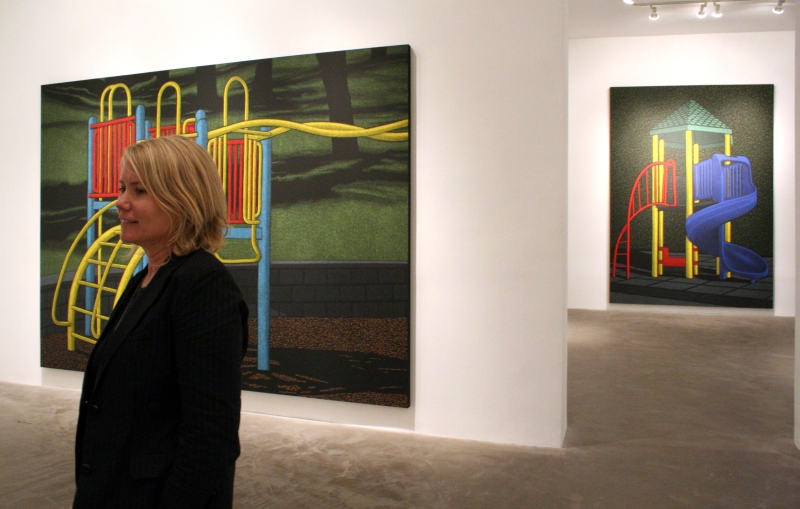
What is your favorite part of the process?
Well, my favorite part of the process is drawing. In a lot of ways these are big productions and there’s a lot of pieces to them. The way they were made, trying to figure out the backgrounds, and then how to get the imagery up onto the canvas. But it is all occupied by me just going like this [moves hand as if she’s drawing]. That’s where the bulk of the time is. It’s very physical and very intense and delirious, kind of crazy making at some times. But I’m well aware when I’m working that that’s the good part.
So what’s the most challenging part? Or part you dislike the most?
That’s a good question. It’s like a double edged sword, because there’s one thing in each of these drawings that was incredibly painful – the leaves, the bricks, the chain link – because I didn’t have any assistants working on these drawings with me and because of the repetition and the shape is so small that my hand would really cramp up and there would be these moments where I think I can’t make it. I can’t say that it’s my least favorite part but it’s definitely the most difficult part of it.
Amy Adler’s solo exhibition “Location” will be on view at ACME in Los Angeles through December 20th, 2014. Here work can also be seen on her website.
Painting Chops
 A STUDIO VISIT WITH CHRISTOPHER KUHN
A STUDIO VISIT WITH CHRISTOPHER KUHN
Interview by Virginia Broersma
Before I settled on becoming a visual artist, there was a time when I wanted to be a professional musician. I joined a jazz band led by a true relic of the big band era and was introduced to freewheeling structure of jazz from one of the period’s greats. I learned a lot of things (including that I don’t have what it takes to be a jazz musician) but what has stuck with me are the components that are needed for jazz: understanding of structure (and “the rules”) and gaining the ability/skills to invent and break the rules to come up with something extraordinary.
In a jazz chart, the band begins laying the groundwork – establishing the beat and setting up the basic foundation upon which the soloists float their improvised creations. While this improvisation happens on the fly, its takes years of practice. You need an embedded knowledge of the chord structures, the ability to own the rhythm, and have the confidence to jump without a net. I bring all this up because I see a direct parallel in jazz and Christopher Kuhn’s work. Kuhn’s work involves all the characteristics that you need in jazz – rhythm with experimentation, structure with surprises, and some serious chops.
I’m interested in talking to you about the roles that intuition and intention play in your work. How much of your process is dictated by each step, and how much of it is planned ahead?
They definitely start spontaneously – generally cleaning brushes off and I’ll find some canvases that are prepared and just make marks to not waste paint, basically. I’ll make some moves without thinking about it so much. As that builds up, eventually I respond to it and in the best works there is this balance between the spontaneity and some controlled elements. Sometimes you lose the spontaneity – you employ strategy and it fails so you try something else and that fails, and eventually you’ve lost whatever essence was there in the beginning. But you don’t show people those.
By including spontaneity, does that make the process riskier or easier?
It can be pretty risky. It takes a certain steadfastness, I guess. When I first started this method, because there’s such a risk of failure – sometimes I would get down about it. Sometimes there’d be a work I really liked and I’m really excited with where it’s heading and then suddenly I mess it up and then I get all down. But over time I started to view what (in the moment of making the piece) I would think of as a failure, eventually as a stepping stone towards the resolution. So over time I gained more confidence and more surety to trust myself and not get so worked up in the moment.
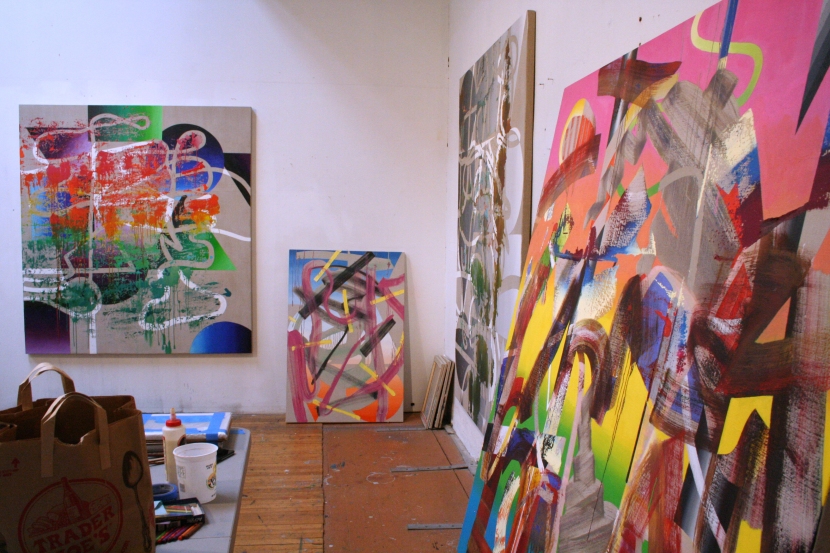
As a fellow painter, I’m interested in hearing your perspective on paint as a material and as your medium of choice. What do you think are the capabilities of paint? And what are its limitations?
Well, I definitely came to art through art history. So, I do honor the tradition of painting, and I’m not so concerned with trying to push its boundaries, or fracture the picture plane, or try to make it sculpture, or blur these lines, which a lot of contemporary art does. I do embrace the limitations of the square or rectangle, the fabric support and the material itself. I find what interests me about paint, and I guess the painted space or image, is that you can create spaces that read logically to your mind, and your mind and eye accept them, but when you really look at it, it doesn’t necessarily make sense. The space that you’ve constructed logically in the world we know is impossible, but in a painting it’s fine, and its agreeable and acceptable.
 The more familiar I become with your work, I am able to see that you address a wide range of formal propositions, which I assume is to both challenge yourself and to keep it interesting. Do you attempt to work within a consistent set of elements? Or do you actively try to work out something different with each piece?
The more familiar I become with your work, I am able to see that you address a wide range of formal propositions, which I assume is to both challenge yourself and to keep it interesting. Do you attempt to work within a consistent set of elements? Or do you actively try to work out something different with each piece?
Before I was doing abstract painting, I was doing representational work. I enjoyed the finished product, but I didn’t really enjoy making them so much. When I was in Boston, there was a show at the Museum of Fine Arts of Cecily Brown, and I saw those paintings and they looked like so much fun to make. And maybe she tortures herself while making them, but for me, seeing them, it looked like wow! that looks like so much fun! I’m not having fun painting; I want to try something else. I slowly headed towards abstraction, and once I finally went for it, what I liked was the unpredictability of it. Since I didn’t know what I was making, it was always challenging and always kept me on my toes.
When I find myself falling into formulas, that’s when I try to change things up. Since I’m experimenting in a lot of the work, I learn new things, new tools, new strategies, and over time I’ve learned how to employ specific strategies to their strongest impact. It’s honing your skills, and finding these tools and knowing when to use the tool. You’re not going to use the hammer for the screw, you use the screwdriver.
What’s you’re favorite part of the process?
Hmm. I really don’t know, I kind of like it all: being in the studio; looking at the work; making the work. I suppose when I’m really in a painting, some of the larger ones they can take six hour sessions over multiple days, I know what I’m doing in that case – it’s just filling in all these areas, so it becomes very repetitive work that’s almost meditative, in a way too, when you’re not thinking about what you’re doing. My mind really wanders then and sometimes I think of old memories…it’s very unconnected to where I am in the studio. I think why the hell am I thinking of that right now? That does happen a lot in making work, and I do enjoy that because it takes me to places I don’t go otherwise.
So what’s the most unlikeable part of the process (if there is one)? Or maybe the most challenging?
What do I want to have for lunch? That’s the great question: what do I feel like eating?
How do you think about other people’s relationship to your work? Do you consider them? Or is the value in the satisfaction you get in making the work?
There are certain times while making work when I start to see where the work is headed and that it’s starting to encroach on other artists’ turf, in a way. I’m conscious of that – so that’s an idea of other artists or other people. But I don’t let that stop me necessarily, because I don’t know where that trajectory is going to take me, so maybe I’ll just step a few steps in somebody else’s area, but in order to get to a different place that’s mine again.
Otherwise, I don’t necessarily think of the viewer so much. I am the viewer myself so I’m trying to make something that pleases me, and then hope that it will please other people in that process.
Tell me about your show coming up here in LA – what’s the title for the show?
Material Witness. It’s a legal term, I have this list in both my phone and here in the studio for when I hear things on the radio, or while watching TV, and think: painting title! and sometimes I think it could be a show title. Material Witness was one of them; it has no relation to art, really, it’s a legal thing that means a witness that can have the potential to change the outcome of a case. But I like it as a poetic metaphor, meaning the material obviously- the paint, the canvas – and the idea of the witness testifying, like the paint and the canvas testify to (in this case) the creation of the work itself. Hopefully in certain paintings you can read how the painting was constructed. In this case the material is speaking for itself.
Christopher Kuhn’s solo show “Material Witness” opens at Sonce Alexander in Los Angeles on November 1st, 6-8pm and will run through December 6, 2014. Kuhn also has a solo exhibition on view at FIELD Contemporary in Vancouver, BC on view through November 22, 2014. His work can also be seen on his website.
Busting It Out
 A STUDIO VISIT WITH BETTINA HUBBY
A STUDIO VISIT WITH BETTINA HUBBY
Interview by Virginia Broersma
Bettina Hubby is an interdisciplinary artist with an impulse towards collaboration and integrating daily life into her art (and vice versa), all with large doses of humor. From cheeky collages of magazine cutouts, to dinner parties with construction workers beneath the twinkle of a disco ball hanging from a bulldozer, her work invites participation and engagement. Hubby has also created a temporary store based in Eagle Rock, selling only rocks and eagle items, and animated the desert with her over-sized “Googly Eyes for Giant Rock”. Needless to say, the breadth of her work is impressive and keeps you guessing what she’ll be up to next. I visited Hubby’s studio in Silver Lake and talked with her about her process and current projects.
VB: My first introduction to your work was your show “Pretty Limber”at Klowden Mann last year, which exhibited some of your collage work and the vinyl cutouts placed on the walls, so mainly your studio based work. I loved the show so much that I wanted to see more and found that you do quite a bit of other things as well – site specific installation, public engagement activities, ongoing collaborative projects with friends and artists. Could you tell me how you see the difference between your studio practice and your more public or collaborative projects? Do they fulfill different interests for you? Or maybe they function in the same way?
BH: Studio practice is a way to get away from the other, and the other is a way to get away from the other. So, it is a bit of a “hide that canvas and go into another space” kind of thing for my brain. The more collaborative projects obviously have to do with wanting more stimulation from the outside world and more conversation based on certain topics that I bring up in that work. I love seeing what comes up that is absolutely impossible to predict based on what other people do. For instance, throwing out this idea 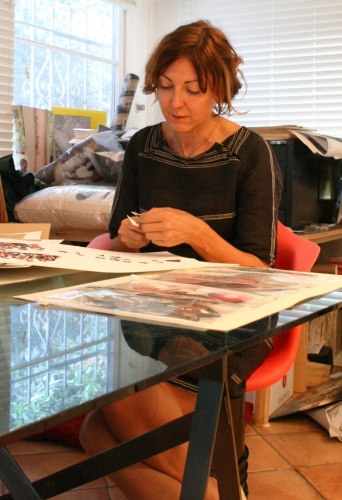 and then having people respond to it and then collaborating with them and making something that none of you could have expected. And then in the studio, reverting to a quieter place. It’s very important, and I have to get better at it, honestly, I have to get A LOT better at it.
and then having people respond to it and then collaborating with them and making something that none of you could have expected. And then in the studio, reverting to a quieter place. It’s very important, and I have to get better at it, honestly, I have to get A LOT better at it.
What do you mean by that?
Well, the silent practice. Really getting away from that compulsion to involve a lot of people with everything that I do. For instance, right now I am involved in this bigger project, which leaves me almost no time for the quiet practice. And I need to get better at balance.
Do you think it’s about allowing yourself the time for yourself?
I think it’s about saying “no.” and scaling back and editing.
You’ve talked about using humor as a coping mechanism, and something I picked up on in some of your projects is this making the best of a situation mentality. So are those two things – humor and making the best of something – the method or the goal in your work?
I think it’s a bit of both. I don’t really like to spend a lot of time, you know, wallowing; and I don’t enjoying when other people do, so I’m trying to fill my life more with positive experiences as much as possible in this world that is very chaotic, and there’s lots of feedback and white noise, and information. Whatever positive experience we can give to the other is really vital. I have a sense of humor and I enjoy others’ senses of humor, and I figure if I can incorporate that as a medium it can be powerful.
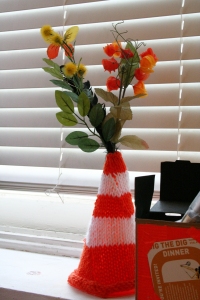 What is your favorite part of your process?
What is your favorite part of your process?
It certainly isn’t the beginning, because it’s too nerve wracking not to know if it’s going to work! I think it’s around that 78th percentile, when you’ve got the ball rolling and the train is moving and everything is coming together and you’re seeing all the images. That goes for the quiet solo practice as well as the collaborative one, where you see the end in sight and you’re pumped and excited, and so are other people as well.
What’s the most challenging part?
The beginning, the blank canvas. There’s a great book by Thomas Bernhard called Correction and it’s about that crumpling up of that piece of paper with all your lists on it, and not knowing whether you’re failing, just throwing it away and filling up that garbage can.
So it’s about the attempt?
Yeah, it’s about the attempt and that self doubt; this process of grappling with an idea whether it’s important enough to follow through with, whether anyone else will care. I don’t want to work in a vacuum; I do want to affect others in a positive way.
If one were to go check out your Facebook page right now, they would find that it’s covered in breasts….images of boobs, stories involving boobs, boob jokes….tell me what’s going on with that?
(Laughs) Well, that was, I guess, The Ultimate in testing out that theory that humor is good medicine. When I was diagnosed with breast cancer in January, I had to, sort of, decide rapidly what to do. It became a major crossroads as to whether to hide out and to be a little nugget by myself (with my family and friends of course) but not to be public about it, because of the shame and the fear and all those confusing emotions. Then I just kind of wiped that and made a decision to be public because that is a part of my nature and I felt like I’d be cheating myself and my nature if I didn’t incorporate it into my world and my art.

So I announced it ON Facebook, which was funny to me, but also startling; using the medium in a different way, with a health issue, but also using humor and just saying: look, I don’t want any pity party here, I just want boobs. Send me boobs: pictures, poems, songs, whatever you can come up with to make me laugh. Because really I don’t need anything else. It just became this free for all, and it was so energetic and exciting to open up that Facebook every day to find new images… from the most unlikely people that had been in my life for years and they were all sending me images of boobs, and all these multifarious and unexpected ways and it was just THE BEST thing I have ever done.
I’m so proud of my bravery, and also really thankful for people’s acceptance and their willingness to participate in this way. And what I hear from others, it was a great way for them to cope and help.
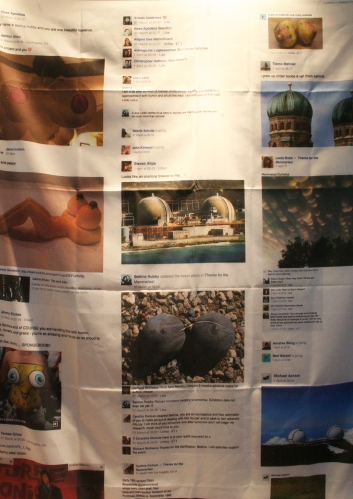 I thought it was special to be asked – even though you didn’t ask me personally, per se, but that you would be so forthright with your community and even as far as it extends on Facebook….I think it’s great to see what people, if given the opportunity, will do.
I thought it was special to be asked – even though you didn’t ask me personally, per se, but that you would be so forthright with your community and even as far as it extends on Facebook….I think it’s great to see what people, if given the opportunity, will do.
I’m actually going to make a full scale reproduction on silk of the Facebook feed. So it includes every post that I got from the day of the announcement to yesterday. I’m still getting things, but I have to cut it off somewhere! (laughs).
It could go on forever!
So that will be up at the show that I’m putting together.
Yes – tell me about that show, “Thanks for the Mammaries,” coming up at ForYourArt here in Los Angeles.
It just seemed a natural progression because I got all these images and I wanted to share them beyond the digital realm. I’m very tactile. I started to look for a space – I really wanted For Your Art from the beginning, so I sent them a proposal and we found a slot that worked and they said “yes” which was just dreamy. I made the open call, I did not curate this, I just said “yes” to everyone, which may not be the best thing for my health, seeing as how I have 112 artists in the show! But in the end, it’s a huge testament to the community and also it will raise some money for breast cancer research, and it’s a nice kind of end point to this particular phase of my life.
What else are you working on in the studio?
I’m going to work on a whole series of collages about relaxation. (laughs)
Good timing!
Yeah, it’s really funny and apropos.
Do you have any exhibitions coming up where we can see your work?
I am doing a show in November of a series of bronzes that will be slightly sexual in nature, but not obviously. For example, I have a slab of cheese and some Q-tips, a washing up sponge and some Vienna sausages…and I’ll do some lithographs with it. That will be at 5th Floor Gallery, so looking forward to that and another year of adventure.
Bettina Hubby is represented by Klowden Mann in Culver City and her work can also be seen on her website. The show which she initiated and worked to organize in partnership with Klowden Mann, “Thanks for the Mammaries,” will be on display at ForYourArt in Los Angeles, CA from July 31 – August 17, 2014. Works by over 100 artists will be on display, most of which are for sale. Funds raised at the exhibition will go towards breast cancer research. Opening reception will be Thursday, July 31st from 7-9pm.
An Entry/Exit Blur
 A STUDIO VISIT WITH KIKI SEROR
A STUDIO VISIT WITH KIKI SEROR
Interview by Virginia Broersma
Kiki Seror’s work vibrates actively between concepts of seduction, sexuality, privacy and voyeurism, engaging herself and the viewer in moments of intimacy and surprise. She taps into the use of surveillance and technology and enters the world of online sexual platforms from chat rooms to porn sites, all with the eye of a painter and with the inquisitive nature of a pioneer. As an actual trailblazer in the realm of digital art, Kiki is relentlessly curious in her exploration of material, method and experience as seen in the breadth of her work from Chatroulette performances to stereolithography. I recently visited Kiki in her studio to talk about her work and our conversation ended up encompassing ideas of forming identity, being surprised and being seduced.
Virginia Broersma: So…easy question: what are you working on right now?
Kiki Seror: As you’ve witnessed, I’m in the middle of stretching some canvases. So in my next pieces I’ll be going back to painting. I think my move to Los Angeles has made me want to be physical and work with my hands. L.A. is a physical and material city. Greatest joy is to work out unique techiques to image making. I feel that truly sets my work apart. I really want to question whether or not the image I am making is still going to be a painting. Or even if I use a photographic means, is it a photograph? Is it just an image? So really trying to go between these scenarios. Somewhere between action painting and documentary photography.
VB: So that describes some of the technical aspects of your work. In regard to subject matter, I wanted to talk with you about two oppositional or perhaps complementary ideas I see in your work: intimacy and detachment. One of the first pieces of your work that I saw in person was “Modus Operandi” – a video piece that is a close-up of a woman applying makeup (so it’s very intimate) and you feel very close and connected to the person. Then in some of your other work, you create more distance between the viewer and the image through blurring and layering to distort the image. Do you think of your work in those terms – intimacy and detachment?

KS: I do – it’s ironic, for instance in “Modus Operandi,” I’m working with imagery of the woman and her toiletry, or a ritual of putting on makeup that can be so intimate. However, the actual production of it is a video camera on top of the makeup brush…the models did not know how they were going to look, so there’s a realism, and maybe that is the intimacy. Even though it’s a very personal moment when you’re putting on the makeup, it is this unknown mirror – surveillance – and that they have no idea how they were going to be seen, even though they are doing everything to be seen.
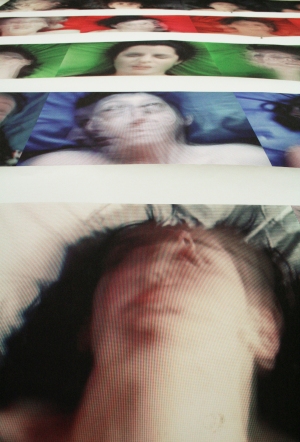 VB: I also find it interesting and somewhat surprising that the pieces that feel more detached (in some ways) are the pieces that are more sexual in nature. Is a sense of detachment something you are aiming for?
VB: I also find it interesting and somewhat surprising that the pieces that feel more detached (in some ways) are the pieces that are more sexual in nature. Is a sense of detachment something you are aiming for?
KS: It’s the uncertainty. There’s this duality that exists online; is it going to be porn or is it going to be romance? It just happens to be about sexuality because when you’re interacting online, there is possible exposure to unfiltered/uncensored user-generated content, what happens in a group setting is that it debases to the lowest common denominator, and fortunately or not, it’s been about sexuality. So when does sexuality become pornography? It’s not that I’m detached; it’s that I think I am going back and forth. The motion of entering and exiting the online social space is what’s creating a blur. Am I being seduced? Or is this just a part of being objectified online? The subject is the medium, and not an object.
VB: Another blurring that happens in your work is the between the distinction between public and private. You talk about surveillance, and obviously you work with intimate themes… my question is twofold – how do you think about incorporating others, specifically in the pieces that are online that involve another person – and then also how you think about incorporating yourself and allowing for yourself to be publicly visible in private things?
KS: What I was known for or first got attention for doing was adult sex chat lines, we were all anonymous in the chat rooms back in the beginning, the original social media . That was almost a call and answer to words without a face- like a jazz musician. I put out a tune – like, “(whatever my url name was) enters the room,waves hi, with dildo in hand, waiting for instructions”. In a way I am teasing but I’m looking to be teased as well.
Years later, I entered Chatroulette. I learned how to in a way bypass a flash input signal, and I then I had running in the background on my desktop a software which acted as a broadcast blue screen, and then have that person see themselves come through me, as they were looking at me. It’s heavy: allegory. They were surprised. You think you’re safe, you’re in your home, but you want to be seen. You think that being seen is vulnerable enough, but wait ‘til you see your image manipulated by somebody else – that’s vulnerability! And that was the piece.

VB: One of the problems I’ve seen with work that incorporates women in any exchange regarding sex/sexuality/gender is that it ends up as exploitation, despite its best intentions. Do you think about exploitation in your work?
KS: I do – that’s one of the reasons I first worked with language. I felt that language itself, in a way, was more personal than the representation of my body would have been. My heroes – the feminist performers of the 70’s like Hannah Wilke – their critique was they were so beautiful and, in a way, they kind of exploited themselves, or they weren’t taken seriously. I just didn’t even want that to be an issue.
VB: What’s the most challenging or disliked part of your process?
KS: Oh! That’s probably the exhibit! (laughs) because to me, the work is so dead by that point! No, it’s not that it’s the most disappointing, it’s the saddest part. It’s hard for me to repeat myself. In a way I’m against signature style. One of my heroes is Martin Kippenberger and why? Because he never bores me and I know that guy was never bored in the studio himself.
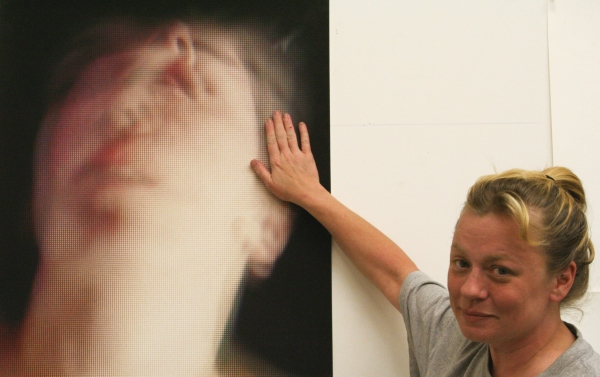
VB: What’s your favorite part of your process?
KS: My favorite part is when I set out to do something technically, and it does something else and I’m surprised by it. Or I had no idea the medium could handle it. It’s the unknowing that I’m happy with, and striving for, what I need in order to create. To witness, at that moment the outcome is magic. The second time I repeat a result, I know I own the method, but to keep repeating a style is tragic. I guess I get bored easily with the familiar.
VB: Where can we see your work?
KS: I am pleased to be included in a book called Artists Talks, a collection of interviews conducted by Gerald Malt from the Vienna Kunsthalle, published by Moderne Kunst Nürnberg. That’s coming out this June and it’s funny because that’s an interview that was conducted around 2007-2008 and it’s just being published! I think looking back at those words and at that time will be interesting.
Then I’m in a two group shows. First one is curated by Tucker Neel called “May Contain Explicit Imagery” will be CB1 Gallery, Los Angeles in the summer. And the second show called “Itch, Scratch, Scar,” will open in September and be held at The Fellows of Contemporary Art (FOCA), Los Angeles.
Kiki is represented by CB1 Gallery in Los Angeles, and you can also view her work online here.
Back and Forth: A Studio Visit with Tom LaDuke
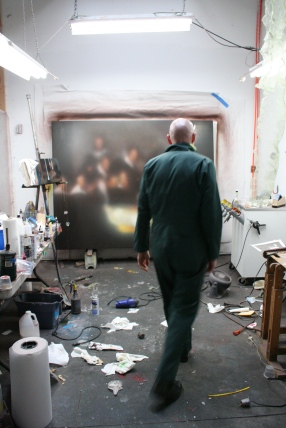 In some ways, a Tom LaDuke painting can seem like a tease. Images that are painstakingly rendered to perfection are blocked by smeared daubs of paint or confounding painted reflections, which leads me to feel both an anxiety and a thrill while looking at his work – like a maddening itch that I am just about to relieve with a scratch. I immediately want to “get” his work – to be able to figure out all the references and pick apart the layers which seem so clear, but he blocks you by obscuring the obvious. This effectively makes his work all the more exciting to look at as the bits of information disentangle and augment each other in unexpected ways.
In some ways, a Tom LaDuke painting can seem like a tease. Images that are painstakingly rendered to perfection are blocked by smeared daubs of paint or confounding painted reflections, which leads me to feel both an anxiety and a thrill while looking at his work – like a maddening itch that I am just about to relieve with a scratch. I immediately want to “get” his work – to be able to figure out all the references and pick apart the layers which seem so clear, but he blocks you by obscuring the obvious. This effectively makes his work all the more exciting to look at as the bits of information disentangle and augment each other in unexpected ways.
Technically, his work is incredibly precise and speaking with LaDuke shows the precision of his mental acrobatics as well. Both healthy skepticism and complete enthusiasm seem to tie him to his practice. His brain is going a million miles a minute, mulling over the logical and philosophical possibilities of his work and I recently had the pleasure of going along for the ride.
Virginia Broersma: What are you working on right now?
Tom LaDuke: I’m working on a show opening on May 1st at CRG Gallery in New York. I’m making nine paintings and four sculptures – maybe five sculptures. It’s all new work, so I’m terrified as usual, (laughs) because who knows if they’re good or not?
How do these new pieces and your previous work relate or differ?
Physically they have a link because there’re layers of information that coalesce on the surface. It’s funny: I’m always trying to understand the puzzle of reality. I use bits of reality, known things, or conventions of painting or sculpture to give me a doorway to stand in and a direction to look.
I can’t remember who said this, but knowledge never created anything, and I think that’s right on. It gives you a framework, but “creativity” lies beyond it. They say that the origin of creativity terrifies us because it is unclear to us. All this is exciting to me. My shrink calls me a “Fire Toucher…”
Like you know you shouldn’t so you just have to. That’s kind of a good description of my process too. I like to build something up, like the surface of the painting I’m working on. It has to be perfect (or as close to perfect as I can get) without compromise, and this makes it worthy of being destroyed by the next layer.
With that in mind, how much of your process allows for spontaneity and improvisation? From layer to layer, is there room for that?
That’s a really great question because there’s a combination of spontaneity and improvisation throughout the work. I think it’s a cop out to say I’m using my intuition, or to make a purely abstract painting, because I don’t think either really exists. Anything you do, including the reason you’re doing it, is connected to all this other stuff that’s going on. Inside that framework of my paintings and sculptures there are a lot of moves going on and I don’t know where they’re coming from. They seem to be guided by something else, but I do not think they are arbitrary either.
You have to really get in there and push it over the edge. There’s a lot of control in my work; that’s how I enter making things. But the control is never the interesting part. The interesting part is when you push your control beyond your capacity to allow for spontaneity and improvisation….
 This also goes back to the Fire Toucher thing: if it registers as impossible, I’m MOST interested in it.
This also goes back to the Fire Toucher thing: if it registers as impossible, I’m MOST interested in it.
That relates to one of the questions that I always ask the artists I interview: what is the most enjoyable or most satisfying part of the process for you?
I’m so lucky – it’s all good. It’s all fun. But I guess the best moment is when I get a glimpse of my location. And I don’t mean geographically, I mean where it all seemingly seamlessly connects.
So, when something switches over from the unconscious to conscious, or from the unknown to the known, an invisible gap is crossed that can be felt in which you know you’ve just learned something. The feeling is satisfaction from having recognized and remembered what was learned, like you’ve always known it somehow.
The switch over between running on automatic pilot (within the ideology of it all) and suddenly seeing an image of yourself in a moment of clarity – that’s a good moment.
You can’t falsely generate it; it just happens.
What’s the most challenging part of the process? Or unlikable, since sometimes challenging can be likable…but where is the struggle?

I guess that would be deadlines. There are always deadlines, but also I’m really thankful for deadlines, because if I didn’t have any, I’d be pretty bored or broke. So they’re good to have, but they freak me out, because there’s never enough time. That’s been a big thing in my life that I’ve had to work out. I think that’s the worst part.
How do you see your sculptures and paintings relating to each other? Do they satisfy different impulses for you or are they different means to the same end?
Different means to the same end. I think it’s all the same, basically. Everyone has been trying to fight the static nature of painting and sculpture for quite a long time now. Whether painting and sculpture are seen in a white cube or someplace else – the viewer still has to be “in the know” to see what it is that they’re seeing so it kills them. We’re all working on corpses and trying to breathe some sort of life into them in our own way.
What do you mean it kills them?
Oh – they use this example in a lot of, what is it – Laconian theory – every word is a tombstone replacement of what it’s referring to. As soon as you notice something, it becomes a still life. The Dutch masters attempted to capture their reality on canvas but the closer they get to it, the deader it became because everything alive is in motion. As soon as you stop it, it kills it.
Tom LaDuke’s work can be seen here and at his upcoming show at from May 1 – June 14, 2014 at CRG Gallery in New York.
Twisted Myths: A Studio Visit With Laura Krifka
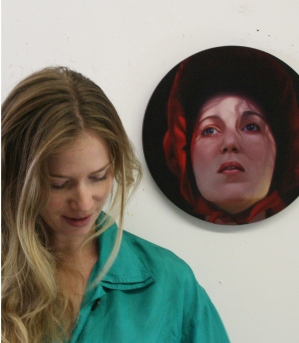 With only a quick glance at Laura Krifka’s paintings you could easily miss the deviance of her characters and the surprisingly naughty to sinister innuendos that she concocts. With art historical allusions and adept technique, her work lures you in and then reveals its surprises that further complicate what you think you’re looking at. I had seen a few of her paintings in group shows around Los Angeles including the most recent one, Rogue Wave ’13 at LA Louver, during which Krifka gave an artist talk. Hearing her talk about her work sealed the deal for me to be totally impressed with her as a painter, artist and all-around engaging person to talk with, so I was very excited to have her all to myself during a recent visit to her studio.
With only a quick glance at Laura Krifka’s paintings you could easily miss the deviance of her characters and the surprisingly naughty to sinister innuendos that she concocts. With art historical allusions and adept technique, her work lures you in and then reveals its surprises that further complicate what you think you’re looking at. I had seen a few of her paintings in group shows around Los Angeles including the most recent one, Rogue Wave ’13 at LA Louver, during which Krifka gave an artist talk. Hearing her talk about her work sealed the deal for me to be totally impressed with her as a painter, artist and all-around engaging person to talk with, so I was very excited to have her all to myself during a recent visit to her studio.
Virginia Broersma: Can you talk a little about what you’re working on right now? What are you most excited about?
Laura Krifka: Right now I’m working on a painting called “Kiss Off”. It’s a female nude, upside-down, half submerged in water with nothing showing but her open, gaping mouth and its reflection in the water. It will be shown at the BravinLee Program’s booth at the Untitled Art Fair in Miami, December 4-8, 2013.
VB: I’m curious about the specific male and female roles in your pieces. You play around with who is the victim, who is the object, who is the perpetrator. This new one is a good example of that – it looks like a (probably) dead woman – could you talk about how you think about gender roles, how you choose between male and female for your subjects and how you see that decision as being important in your work?
LK: I think when you see a victim that’s male, it feels different than a victim that’s female. In some ways male violence seems…I don’t know…more surprising than female violence. We’re so used to seeing females victimized opposed to male figures because of the things that we fetishize in our culture.
Why did I do this one female? One reason was that I just really liked the idea of the disorienting view of upside down giant breasts, (and not like boltons) like fleshy breasts sliding down a body. It feels it could be sexual but could also be like decay – the way that flesh starts to slide off the bone.
So for me there was an interesting correlation between sexual flesh moving and the scariness of your flesh decaying. I like the idea of how female sexuality is rooted in its transience and its linked with death – the breast will only be perky for so long – and so it seems to me that those two things are really linked culturally: female sexuality and the fleetingness of it leading to our own death. And so for me the painting is about that – the sort of inner turmoil of feeling my own mortality….but that makes me sexy….cuz I’m gonna die! (laughs).
VB: You also have some pieces, for example I’m thinking of “Mine Eternal”, where you have a man who is on display – he’s the object of our gaze. Are you thinking of that as a power play reversal?
LK: The painting “Mine Eternal” is based off of the mythological story the Sleep of Endymion, which is a story about a moon goddess named Selene who falls in love with a shepherd. She thinks he is so beautiful so she asks Zeus to have him; she wants him to be hers. So Zeus puts him to sleep for a thousand years and he never ages and she comes down as a moonbeam and sleeps with him every night and produces fifty daughters.
Basically it’s a rape fantasy; it’s this eternal rape that happens of this sleeping youth for a thousand years. So yeah, it’s a role reversal. I guess one of the reasons why I love mythology and I come back to a lot in my work is because it seems like it’s always rooted in things that we’re all terrified of but also interested in; it’s just really rich territory to explore visually.
VB: And still relevant.
LK: Yeah, completely relevant.
VB: What is the most exciting part of the process for you – what do you have the most fun with?
LK: It’s all fun. There are so many steps to me making the pieces and each step has its own particular pleasure. I love brainstorming – that’s really fun, where my brain’s going a million miles a minute. Building the models is fun, because there’s this moment where it’s completely from my imagination. It’s completely here in my head and then it’s suddenly there and I can show it to somebody.
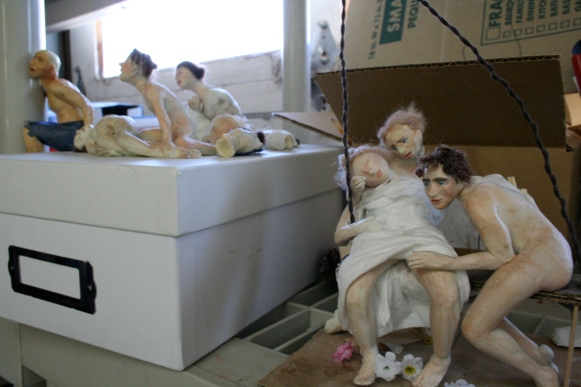
And when I start the painting – painting is just so pleasurable. I love that there’s something that I can do that involves craft still. It’s so fun to engage in that craft. I know craft used to be a dirty word, but I think it’s a really good word now.
VB: Then what would you say is the most challenging or difficult part? Is there one?
LK: Actually making the painting. Even though I love it, it’s challenging and difficult. I have skill but I am always doing something that I don’t know how to do so I stay interested. But painting is really hard! It’s an incredibly difficult thing to do, and having to be honest with yourself the whole time. Having guts to do things you don’t know how to do and to just go for it and actually being honest with whether or not you like it. That’s really hard.
VB: You live in Ventura and teach in Santa Barbara, so have some distance from LA, even though you are represented by a gallery there and you exhibit there. I’m interested to know if you like being on the outskirts? Or if you feel disconnected to the nearby LA art community? I’m curious if it’s difficult? If it’s intentional?
LK: It’s intentional. I really like having an easy life so I can have a difficult studio. I can be challenged here. Other reasons – I just really, really like nature. I like being able to see trees and see mountains and the ocean. I feel more connected to the things I actually care about. I love looking at art, I love talking about art but my art isn’t about art. And so I need to be surrounded by things that let me think about the things I actually care about.
I love going to Los Angeles, and I love seeing things. I can go and get inspired, or furious…and then I can come home and put it in a box and pull it out when I want to think about it. I feel very autonomous here.
Laura Krifka is represented by CB1 Gallery in Los Angeles and BravinLee Programs in New York. Her work will be shown at the Untitled Fair in Miami at the BravinLee Programs booth on December 4-8, 2013 with a private preview on December 2, 2013 and can also be seen on her website.
Wham! A Studio Visit With Emily Silver
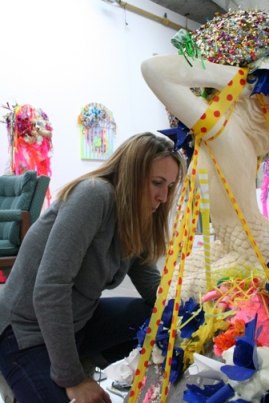 Interview by Virginia Broersma
Interview by Virginia Broersma
Emily Silver makes work that is as visually calm as an air horn. Objects, drawings and videos that may have literally been involved in some kind of explosion or had their glitter-and-ribbon brains bashed out with a bat fill her studio, which upon entering happens to look like you’ve arrived just a little too late for the party. With closer inspection you see that her work has many components assembled in layers – carefully crafted, manipulated, destroyed and rebuilt into something completely unordinary, fun and a little bit dark. I have the advantage of being Silver’s neighbor and get to see the “behind the scenes” of her process on a regular basis, but with her work currently included in the Sur Biennial, I thought it would be great to sit down and talk more in depth.
Virginia Broersma: Your work often looks like you found the remains of a birthday party gone overboard and used the detritus to build your objects. Glitter, ribbon, faux-flowers, balloons and frosting-like paint all make recurring appearances in both your drawings and sculptures. Could you talk about your interest in parties and the Celebration?
Emily Silver: I think the celebration in our lives becomes a time stamp as we grow older, and through memory we remember things that happen in our lives by reflecting back on the celebration. I’m interested in this quick rise of an event and how quickly it turns bad; its something that’s so treasured and cherished, and then immediately becomes garbage and it’s left over and we want to get rid of it as soon as possible.
So I’m interested in using these materials to elevate them – to give them another life: a new life that’s much more precious than the moment that they live in. I’m also interested in that there’s a bit of the ridiculous and tragic in these events. When you are going to a party, the idea of it is so much better than actually being there. Because its over – once the day comes its already over, things are already 50% off. I’m interested in that – how fleeting these moments really are.
VB: In preparing to do this work, you’ve taken jobs related to these situations – you’ve worked at flower arranging, which is usually involved in weddings and other typically positive celebrations, and then you’ve worked in a funeral home with the same purpose.
ES: Yeah – that’s come in quite a bit. I worked in a mortuary for a while doing flowers for funerals. That was one of my favorite jobs. When I moved to LA it was the first job that I got here and it didn’t help me make any friends at all – I’d eat my lunch in the cemetery – but I purposely did it because I feel like sometimes to research you need to be fully immersed in these things. So moving 3000 miles away and then working with the dead was a great experience for me.
VB: Your work makes me think about the emotional arc of these events- the anticipation, excitement, the delirium that happens at these festive events and then the let-down at the end of them – the psychological comedown. Your pieces have a very celebratory look,- they’re colorful and bright – and then the titles might allude to that tragedy that you mentioned. So are you thinking about the psychology of the experience of these things?
ES: Absolutely. I absolutely think that there’s something in the moment -whenever you’re caught in any moment –for example, you get in a fight with somebody, and have had too many drinks at a party, you tend to act or do things that you wouldn’t normally do, and I’m super interested in that emotional curve like you were talking about. I will often put text in or these titles that have a bit of a sting on purpose so that there’s an attraction and a repulsion.
The neon comes in a lot with that because neon is supposed to be a warning. We use them on road cones and when somebody is working on the street – its like a “beware” but we have a rat-shiny problem and we want to go towards the light. I like that kind of attraction and then repulsion; the pleasure and then the sting that happens.
VB: I’ve gotten to see you work in the studio quite a bit and I know you have a lot of fun in the studio. You constantly play with materials and amuse yourself with the sometimes silly and comical possibilities of your work. What role do you think humor plays in your work?
ES: I think humor is important for everybody to have. I know sometimes it’s not something that people think or want to take seriously in art work. I’m not saying you should come and laugh a lot at the work, by any means, but I think having a sense of humor in tough times and having a sense of humor when things aren’t going right, has been for me the best way to deal and to cope with things.
I also think it’s a great way to communicate to people. If I could be something else it would be a comedian, but I guess both jobs would be failures at the bank. Either way I feel like I’m talking about the everyday and sometimes the mundane in material or in subject matter, sometimes the celebratory, but every time I’m trying to find that space where it IS funny. Right before or right after it was tragic, after I put the baseball bat in.
The moment of bashing something with a baseball bat is really hard to do in your own work, its taking a big risk, it could fail, but then at the same time its very funny afterwards and I think that’s what true comedy is. Post-tragedy, post-accident, or not taking one’s self too seriously. I do want people to have a good time, but I also want people to have a moment, at least once, that they have with the work that they go someplace a bit dark. And then maybe they bounce back.
Emily Silver’s work can be seen in the Sur Biennial at Rio Hondo College Art Gallery through November 18, 2013 and at www.emilysilver.net




